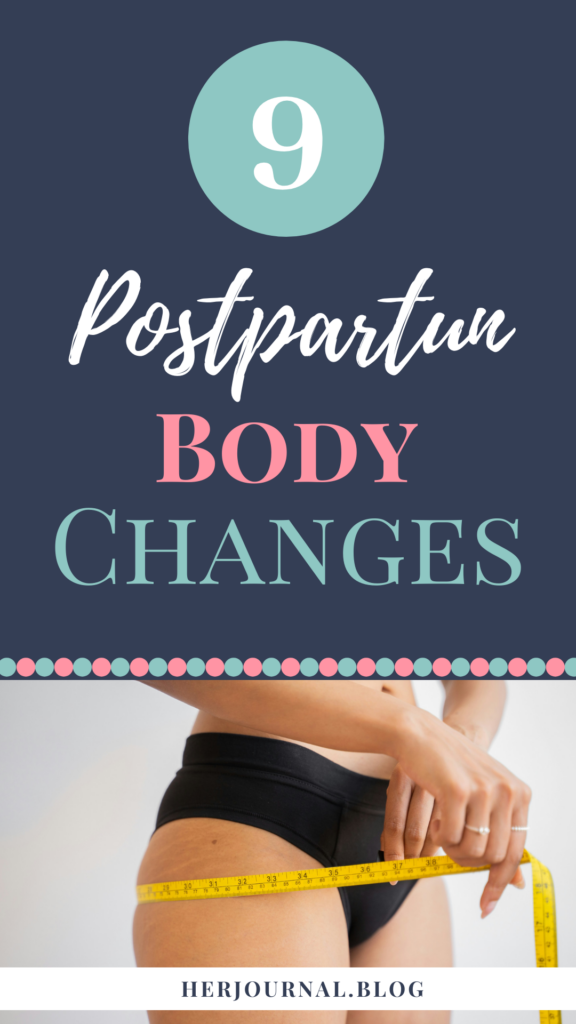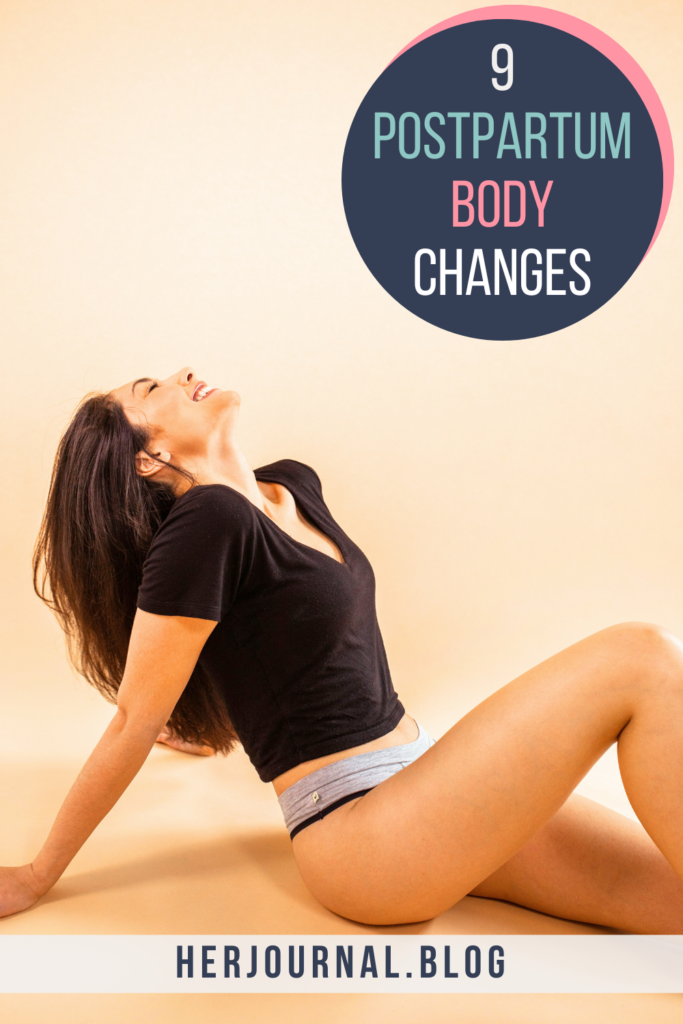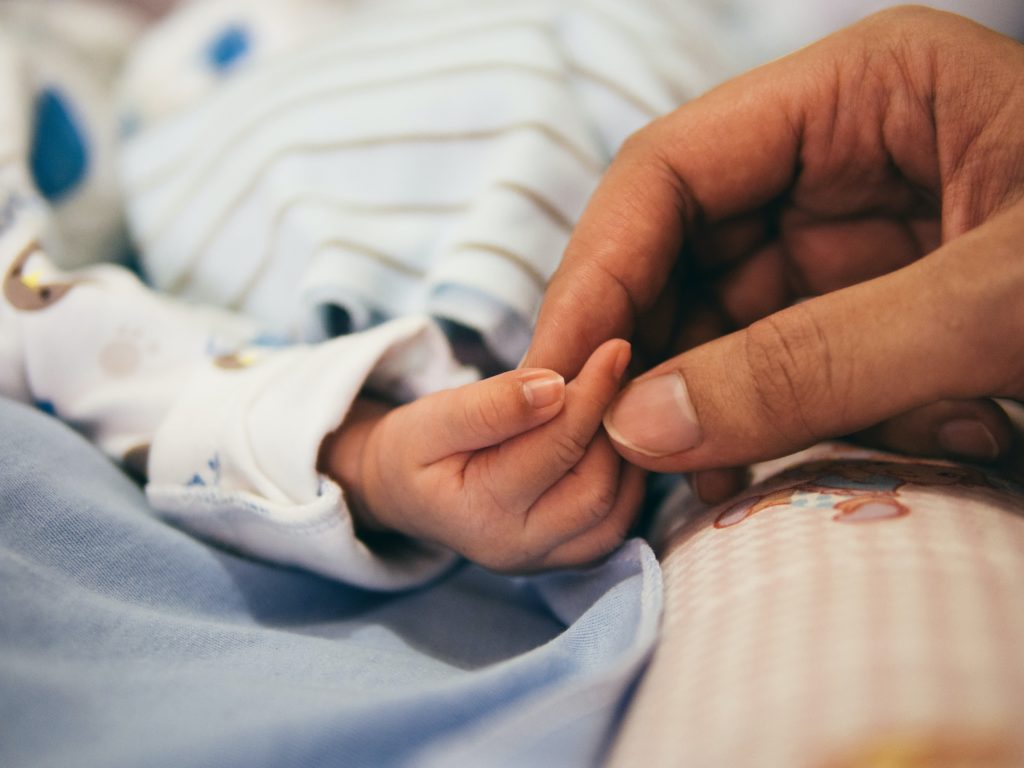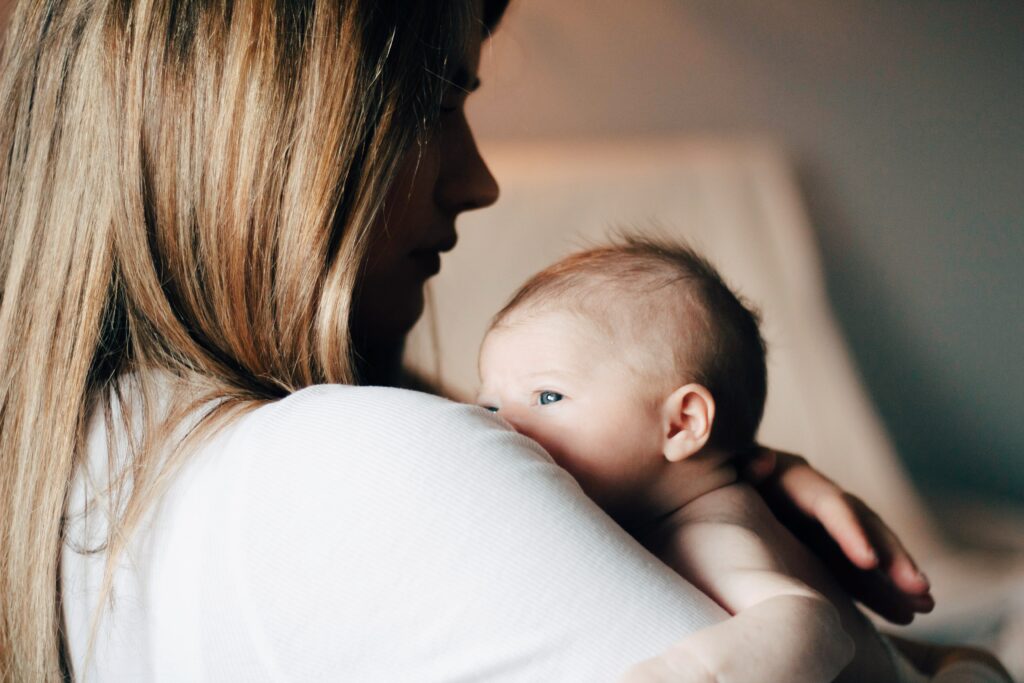We may earn money or products from the companies mentioned in this post.
Last Updated on September 10, 2024 by Samantha Flores
It’s no secret that your body changes during pregnancy. You can visually see these changes occurring each month as your unborn baby grows and grows. However, many women don’t realize how many postpartum body changes occur.
It’s more than a saggy tummy and some stretch marks. The postpartum period is full of healing from pregnancy and some new changes. If you weren’t expecting additional changes after pregnancy, then you might be in a state of shock at all of the new things your body is experiencing.
While many changes will happen within the first six weeks postpartum, there are postpartum body changes that can occur months after you have given birth. The trick is to understand the changes so that you can accept them as the new you.
Related: The Postpartum Period: How to Survive After Birth

9 Postpartum Body Changes You Should Know
The list of postpartum body changes will vary from woman to woman. However, I wanted to create a list of common changes you may experience and others that may surprise you.
Postpartum Hair Loss
One of the changes I didn’t realize would happen after my first baby was postpartum hair loss. Roughly half of postpartum women (40-50%) will experience hair loss at some point after the birth of their baby. This is due to the sudden decrease in hormones once pregnancy is over. Postpartum hair loss can be one of the more difficult postpartum body changes to accept.
As a mother of three, I have experienced postpartum hair loss after all three of my babies were born. However, I didn’t experience hair loss at the same time after each birth. With my first, it was roughly four months postpartum when I started to lose my hair. With the second baby, it was around six weeks postpartum and 10 weeks after my third baby.
Women who experience postpartum hair loss will lose about one-third of their hair. It seems like a lot, but it happens over time. There are ways to help postpartum hair loss. Read here to understand how to help with this challenge.
Pelvic Floor
When you give birth, your pelvic floor goes through a traumatic change to deliver your baby. It has to spread and separate in order for your baby to pass through. After birth, it takes time to heal your pelvic floor.
You might experience urinary incontinence for some time due to this change. In addition, you might experience lower back pain, anal fissures, or discomfort in your hips. These are all symptoms of your pelvic floor changes.
Before you begin any kind of exercise or workout program after having a baby, consider investing in pelvic floor therapy. I did this after my third baby, and I really wish I had taken the time to do it with my first two. You can even participate in pelvic floor therapy while you are pregnant to stay proactive.
Related: How to Stay Fit In Motherhood: 5 Tips for Success
Weight Gain
Contrary to popular belief, if you choose to breastfeed, that doesn’t automatically mean you will lose weight after birth. In fact, breastfeeding actually increases your appetite. In addition, you need to increase your calorie intake to help sustain this new human. Weight gain can be one of the postpartum body changes you experience.
Regardless of whether you choose to breastfeed or formula feed, postpartum women can experience weight gain. This is partly due to the hormonal imbalance you will experience, especially during your baby’s first year of life. Weight gain is also attributed to the lack of sleep, mental and physical fatigue, and increased hunger following birth.
Remember, losing the baby weight is not the priority during your postpartum journey. Your priority is to heal, bond, and learn during that first year postpartum. Some would even say just surviving the first year is enough. There is no need to add more stress to your mind and body about losing weight.
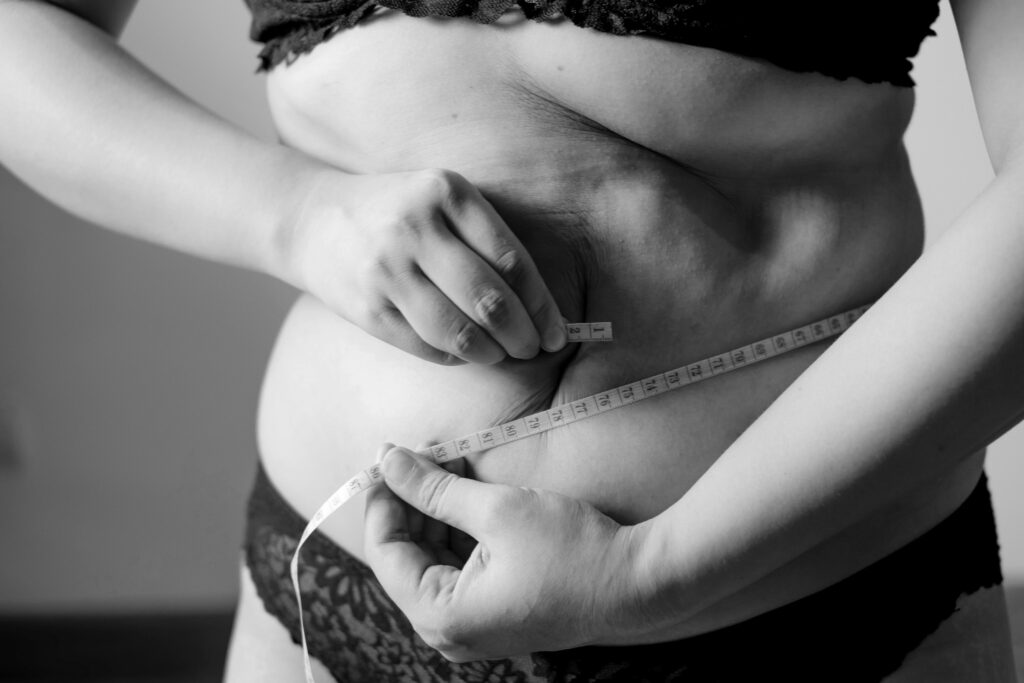
Postpartum Mental Health
The gray matter in your brain changes during the postpartum period. This is the part of the brain that controls your memory and emotions. It’s no wonder why mothers suffer from mental health issues following the birth of their babies.
Think about it… your baby is constantly changing, especially during that first year of life. This requires you to change with them so that you can continue to recognize their cues and cries. This change serves as a tool to help link your brain to your baby.
In addition to the hormonal imbalance, changes in this part of the brain introduce self-doubt and feelings of inadequacy. Many moms don’t understand what is happening in their bodies or their brains, which can be scary to experience.
Many postpartum mental health disorders occur at various points after birth. Some mothers report struggling with postpartum depression and/or postpartum anxiety well past their baby’s first birthday. You are not alone if you feel you are struggling years after giving birth.
Related: Helpful Self-Care Strategies for Moms Dealing With Postpartum Depression
Postpartum Hormones
You already know that hormones play a huge role in pregnancy. When you become pregnant, your body experiences a dramatic increase in hormones. These hormones are estrogen and progesterone, which your body needs in order to sustain the growing baby. These hormones also serve as your happiness and anti-anxiety hormones.
Immediately following the birth of your baby and the placenta, these hormones leave your body. Within three days postpartum, you don’t have your happiness and anti-anxiety hormones in your body anymore. Therefore, you start to feel an influx of emotions you can’t control. This period of time is known as the “baby blues.”
However, these hormones won’t become balanced again until your menstrual cycle returns. This can take months to regulate. The average is around six months. However, some moms don’t get their period back until after their baby’s first birthday due to breastfeeding.
The best thing you can do during this time is keep a journal. Write down your experiences for the day and how you were feeling. You can also doodle random notes and images. The main goal is to keep track of your emotions to see if you are starting to feel better or if you are going on the path of a postpartum mood disorder.
Postpartum Skin Changes
Skin discoloration is one of the common postpartum body changes you may experience. In pregnancy, skin discoloration is referred to as “melasma.” Roughly 70% of expecting mothers experience melasma and typically see changes in their face, neck, and chest areas.
These changes can last into postpartum as the hormones change. In addition, some women who didn’t experience skin discoloration in pregnancy may see changes postpartum. This is all due to the hormone imbalance.
Consult your doctor if you are experiencing any skin discoloration. There are prescription creams and steroids if you are seeking a solution. However, consider the side effects of any prescription as sometimes those can be worse than just waiting to see if your skin returns to normal.

Diastasis Recti
Diastasis recti is also known as “ab separation.” This is the visible separation between the ab muscles that create that six-pack look. Your growing belly in pregnancy pushed these muscles apart. It will take time to heal your core postpartum.
Not every woman experiences the same level of separation. Therefore, treatment will be different for everyone. To help heal your ab separation, consider seeing a physical therapist or pelvic floor therapist who will work with you to strengthen your core again. Doing an insane amount of sit-ups on your own will only prolong your healing.
Related: 3 Common Myths About Life After Pregnancy
Vision Changes
Vision changes are also part of the common postpartum body changes list. These changes are due to hormones and water retention in your body. This causes a “refractive error” in your vision. Typically, time will heal this.
You can speak to an ophthalmologist about the vision changes you experience. However, you might be met with a “wait and see” diagnosis. Many ophthalmologists won’t prescribe glasses if you are within one year of giving birth because the change is temporary.
In addition, to the hormone and water retention, breastfeeding can prolong any vision changes. Keep track of when you start to notice the vision changes and if the changes become worse over time.
Varicose Veins
Varicose veins are common in pregnancy, but they don’t necessarily go away after birth. They may go away partially. However, if you developed them during pregnancy, you can expect that they will likely stick around afterward.
Compression socks in pregnancy can help reduce varicose veins. There are also makeup options you can apply to the affected areas if you are trying to diminish their appearance on your body.
Common Questions About Postpartum Body Changes
Use the following questions to get an even deeper understanding of postpartum body changes. Discover answers to the questions others are asking.
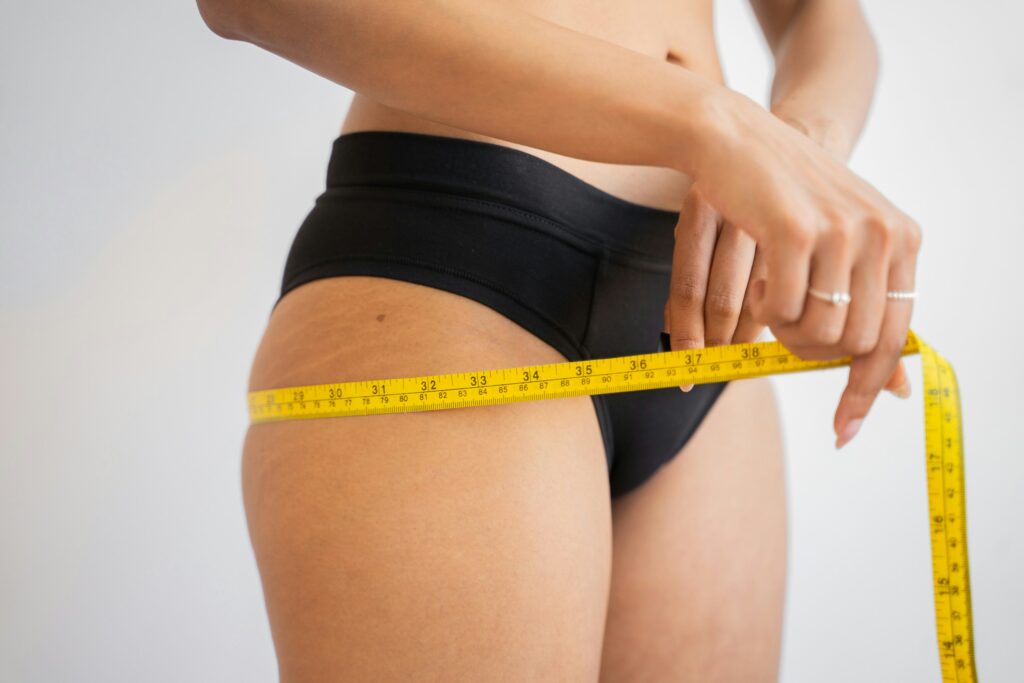
Does your body shape change after pregnancy?
It has taken you roughly 40 weeks to grow a human. Your body has been stretched to many limits and has changed shape to accommodate your growing baby. Many mothers fear that once they have their baby, their bodies will no longer go back to their pre-pregnancy weight and shape.
There will indeed be changes that happen to your body that will cause you to look and feel different after birth. Hormonal imbalances and other shifts that have taken place within your body are proof that you grew life within your body. That is something to be praised!
Related: Helpful Self-Care Strategies for Moms Dealing With Postpartum Depression
How long does it take for the body to return to normal after pregnancy?
As a mom of three, I believe there is no such thing as normal after pregnancy. Everything has changed and continues to change. I have needed to work hard to get my body into a comfortable state, meaning no pain, repairing my ab separation, and losing unwanted pounds. But pregnancy isn’t the only cause for this; life happens.
If you are worried about losing the mom pooch so quickly after birth, you might find that this constant thought process robs you of the joy that can be found postpartum. There will be time to get into your best physical shape after having a baby.
For some moms, this isn’t a priority until after their baby’s first birthday. Consider your goals and discover what makes you happy– then focus on that.
Is it harder to get in shape after pregnancy?
No matter what season of life you are in, it can be challenging to get into shape. You have to make sacrifices, cut out food items that you might enjoy, and change your lifestyle. This isn’t just true for postpartum women. This is true for anyone.
It can be challenging to get into shape after pregnancy because of hormone imbalances, breastfeeding demands, and overall exhaustion from sleepless nights. However, it’s not impossible.
Postpartum Body Changes Happen to Most Women
As you can see, there are many changes your body goes through after pregnancy. While many of the postpartum body changes listed above are common, that doesn’t mean you are guaranteed to experience them all. In addition, you may experience other changes that are unique to you.
It’s easy to accept changes that happen to our bodies during pregnancy because you know there is a growing baby inside there. However, it can be difficult to accept the changes that happen to our body postpartum because we expect to bounce back once that baby is born.
The key is to accept the changes so that you can be fulfilled in your motherhood journey. You are not defined by what you see in the mirror.
Learn about the changes you are experiencing and how you can help cope with them. These changes happen to most women. You are not alone.
Related: A New Mom’s Guide to Navigating the 4th Trimester
Pin It!
